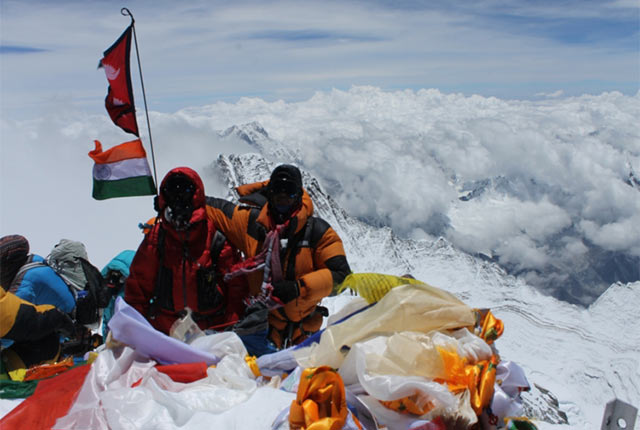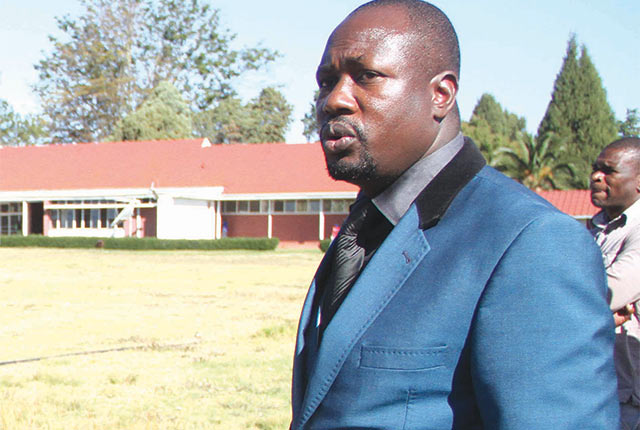Taking Zim to the roof of the world

 Christopher Farai Charamba Features Writer
Christopher Farai Charamba Features Writer
The summit of Mount Everest in Nepal is 8 848 metres above sea level, making it the top most part of planet Earth. Since Sir Edmund Hillary and Sherpa Tenzing Norgay conquered the mountain in 1953, over 4 000 people have successfully scaled Mount Everest in what can be described as the
most gruelling challenge for climbers and adventurers from around the world.
On May 19, 2016, an Indian business couple residing in Zimbabwe, Mr Pradeep Chandra Sahoo and Ms Chetna Sahoo, joined the few thousand other people who have reached the top of the world.
Affectionately known as PC, Mr Sahoo has been climbing mountains for 30 years and has been planning on scaling Everest for the past five years.
“Every climber who has a passion for climbing has a dream to climb Everest and be there on the top of the planet one day.
“My wife and I share a passion for climbing and have been doing so in the Himalayas for the last 30 years. In the Himalayas I have climbed about 20 mountains, five of which are above 7 000m,” he said
The couple made their first attempt at climbing Everest in 2014 but were unable to proceed with their plans after an avalanche killed 16 of the local Sherpa support guides.
“In 2014 we wanted to climb but after the avalanche in the mountain where 16 local Sherpa lost their lives the government of Nepal suspended all climbing. Out of respect, all the other Sherpa support people, who support the climbers from all over the world, said they would not climb over the dead bodies of their brothers.
“We tried again in 2015, this time there was an earthquake in Nepal and this caused another avalanche which killed 22 people at the base camp, usually the safest place on the mountain. Again as a mark of respect climbing was closed,” he said.
PC and his wife finally got their chance to make the historic climb this year.
“The planning for the climb actually started five years ago. One needs to prepare themselves before you go and climb Everest.
“You train and organise finances, book support staff and mentally gear up for the task ahead. Everest, being the highest mountain, has a high degree of challenges. The peak is at 8 848m, which is almost the cruising height of a commercial jet. Anywhere above 8 000m is called the death zone.
“The human body is not designed to survive at those heights and in those conditions. Temperatures can go to as low as -40 degrees Celsius and winds can blow at more than 200 to 250km/h making it very dangerous for a climber,” he explained.
As part of his training PC would run 8-10km during the week and up to 20km over the weekend for endurance.
Between 2010 and 2013 he climbed mountains in the Himalayas to simulate the conditions of Everest as at 4 000 or 5 000 metres in the Himalayas you can find the same level of cold and wind as at 8000 metres on Everest.
According to PC, it takes two months for one to successfully make the climb as you do not just make the ascent to the top in one go.
“I left Zimbabwe on March 25 and went to Calcutta. I left Calcutta on March 31 and reached Kathmandu, the capital of Nepal, and the starting point for the climb on April 1. We were nine in our climbing party; one Polish, one Japanese and seven Indians,” he said.
“A climb goes like this; you first proceed to the base camp which is at about 5 300m, close to the height of Mount Kilimanjaro, that takes around nine days to reach staying at different altitudes. Once you reach base camp at 5 300m you stay there for about three to four days so that your body can acclimatise. The air at that altitude is half of what you have at the lower levels.
“From the base camp you go up to 6 000m, spend a night, then come down again back to camp. After one or two days you go up, spend a night at 6 000m, then go to 6 500m, spend a couple of nights there, then go up to 7 500m, spend a night there, then come down to base camp again,” he explained.
Everest has one popular season for climbing which are the months of April and May. During that period there is a 10-day window in the middle of May when the wind speed is lowest and one can reach the top with the least risk.
“Once the body is acclimatised up to 7 500m, we then check the weather forecast looking for five days of good weather, usually between May 10 and May 25 to make the final attempt. The main thing we look out for is the snowfall and wind speed. Snowfall you can manage but with wind speed of anything above 30km per hour will make life unmanageable above 8 000m.
“From base camp it takes about five days to go to the top and we reached the summit and planted our flags on May 19,” he said.
One of the flags that PC and his wife took to the top of Mount Everest was the Zimbabwe national flag.
“I have been living in Zimbabwe for five years now. When I decided to go up Everest this year the Indian community in Zimbabwe encouraged me to take the Zimbabwean flag along with the Indian flag, my home country.
“The other reason I took the Zimbabwe flag was that in 2014 we had two Africans from South Africa who attempted the climb and in 2015 there were two more Africans from Kenya and South Africa who also attempted the climb.
“I thought to myself that perhaps nobody from Zimbabwe has gone to Everest. This was an opportunity to take Zimbabwe to the top of the world.
“I don’t claim to be the first person from Zimbabwe to go to Everest because I do not have the records to say I am, but I take pride in the fact that I could take my flag and the Zimbabwean flag to the top,” he said.
PC returned to India on June 8 from his expedition and said that it was a physical, mental and financial challenge. A typical climb can cost between $40 000 and $50 000.
“Because you are in the mountain for a such a long period you need supplies like oxygen, food to eat and a place to stay. A lot of money is required to provide to the agency that will support you with all of this. The Government of Nepal where Everest is situated also takes a hefty fee of $11 000 per person as a climbing permit,” he said
Despite the challenges and the dangers, PC intends to make the climb again.
“I plan on going up again as long as my legs support me. There are fears in climbing Everest as it is very dangerous. This year we lost five of our co-climbers, people who were very experienced too. One of them was my close climbing partner whom I had been climbing with in the Himalayas for the last 28 years.
“If the wind is very strong that day or if you run out of oxygen and are delayed then you are gone. I actually almost lost my wife because she was delayed when coming down from the top and she ran out of oxygen.
“Before the oxygen could reach her she suffered severe frostbite on her fingers. About three or four of her finger tips couldn’t survive and she lost them. Due to frostbite, I almost lost six of my toes. They survived and only the nails and some upper skin came off,” he said.
Over 280 people have lost their lives trying to reach the top of the world. One of the earliest adventurers to try to scale Mount Everest, Englishman George Mallory, died during his attempt in 1924. His body was recovered frozen in the ice in 1999 at 8 157m and identified by the name tags on his clothing.









Comments